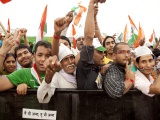Indian Democracy Gets a Wake-Up Call
12 Sep 2011
By Harsh V Pant for ISN
The standoff between the Indian political establishment and Hazare and his thousands of supporters lasted nearly two weeks. Hazare went on a hunger strike for 12 days until the parliament agreed to accept some of his demands regarding the creation of an independent anti-corruption body, known as the Lokpal, empowered to scrutinize public officials including the prime minister. Hazare and his supporters had been demanding that parliament pass legislation on Lokpal during its current session, and that similar institutions be created at the state level to tackle corruption. But this was not a new fight: the Lokpal legislation has been pending for 42 years, and despite several attempts, has never been passed by the parliament.
The government was forced to admit to its bungled efforts at handling the demands raised by civil society groups earlier in the year and at defusing the situation once it had gotten out of hand. The government, then, engaged Hazare directly using a few intermediaries, and reached out to the NGOs who were part of his team. However, the government decided that while negotiations would continue with Hazare and his team, it would not compromise when it came to the sovereignty of parliamentary legislation-making.
Hazare agreed to end his fast after parliament passed a resolution on 27 August following a day-long debate during which it agreed “in principle” on the issues of setting up Lokayuktas in states, a citizens charter and bringing lower bureaucracy under the Lokpal. Many details, however, remain unanswered: the legislation is yet to be fleshed out by a special parliamentary committee; and parliament must still debate the issue. Despite the principled agreement, the government did not allow a direct vote on the protester-supported resolution for fear of exposing divisions among parliamentarians. While the two main political parties, the Congress and the BJP, accommodated some of the demands made by Hazare, the smaller parties were more critical of the protester’s tactics, viewing Hazare’s agenda as one of usurping parliament’s rights.
Winners and losers
The anti-corruption protest movement has been remarkable in its ability to galvanize large segments of Indian society around an emotionally charged social issue. The depth of middle-class rage in the country against the political establishment was exposed during the crisis. More significantly, for the first time in several decades, the democratic institutions of the country have come under scrutiny like never before.
The governing Congress Party seems to have been completely outmaneuvered in its struggle to regain control of the narrative. Its leadership seemed rudderless at a time when multiple corruption scandals were testing the mettle of the Indian government. The anti-corruption bill that the government had introduced in parliament a few weeks back – which had helped galvanize the Hazare movement – was widely viewed as ineffective because it kept the prime minister, the judiciary and much of the bureaucracy outside the purview of the Lokpal. Current Prime Minister Manmohan Singh is powerless and increasingly the butt of widespread ridicule, while the real power center – the mother-son duo of Sonia and Rahul Gandhi – has little of significance to contribute. Sonia Gandhi was in a US hospital for surgery during much of the crisis. In her absence, Rahul and a few senior party functionaries managed the crisis – illustrating the power vacuum in the upper echelons of the party. Then, after first rejecting the notion that a Lokpal was a cure-all for corruption, Rahul – the prime minister in waiting – lost face when his government conceded to Hazare’s demands. While the leadership vacuum in the Congress Party has been extremely palpable, the main opposition party, the BJP, also has not been sure how to deal with the Hazare movement. Although the crisis presented the BJP with an opportunity to take on the embattled government, it recognized that the movement’s tactics could come back to haunt it.
It has not been a full victory for the Hazare camp either. It had demanded nothing short of the passage of its own version of the Lokpal bill, but it mustered only a parliamentary resolution expressing an “in principle” agreement to the provisions it had enunciated. There were differences even among various civil society groups over the nature and scope of anti-corruption legislation. Much of the Indian intelligentsia has been opposed to the Hazare movement – with some even describing its supporters as an Indian version of the US ‘Tea Party’ movement. Prominent Dalit, Muslim and Christian leaders, though supportive of the demand to end corruption, have been rather critical of the tactics employed by Hazare and his supporters in so far as they tried to bypass parliamentary processes. ‘Team Anna’s’ disdain for the institutions that minorities in India have successfully leveraged over the last several years to safeguard their democratic rights is widely viewed as causing some long-term damage to Indian democracy. Mayawati Kumari, the first Dalit chief minister of India’s most populous state, has warned that casteist and communal forces are trying to subvert the constitution under the guise of the new anti-corruption legislation and has demanded that proper representation be given to “scheduled castes”, “scheduled tribes”, “backward” classes and religious minorities.
Hazare’s movement is a populist one, and like all such movements offers simplistic solutions to complex problems. Yet there is no doubt that the Hazare movement has galvanized the urban middle class, and if properly channelled could change the trajectory of Indian politics. It remains to be seen, however, if the movement’s momentum can be sustained to forge lasting change.

